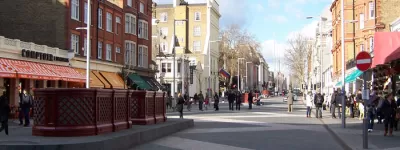In recent years, the introduction of new types of pedestrian crossing — particularly the Puffin, which detects the presence of people and vehicles to calculate the right crossing time and which has confused some users — has been the cause of some debate among highway engineers about the best way to help people cross. But concern over how to get people over the road has been a source of discussion since the motor car first started to jostle Britain's pedestrians for roadspace. Has anything really changed?
This feature looks into the development of British pedestrian facilities, from the humble zebra crossing through to the trusty pelican. It's a more interesting story than you might think — and there's a chance to have a go at some of the different types of crossing along the way.
Introduction

The humble pedestrian crossing might seem a bit dull for eight full pages of history. But a message from a visitor in late 2006, enquiring about a "Controlled Traffic Area" experiment somewhere in London in the 1960s, proved to be the start of a research trail that led to unexpected and fascinating places. One thing led to another and it turns out that the development of the crossings we use today was far from simple.
The day-to-day grumblings of the people who had to use them and the people who had to design them are amusing enough on their own, but the biggest joke is that, for whatever reason, the Men from the Ministry just couldn't come to terms with the idea that it could all be as simple as red, amber and green traffic lights.
The story also contains its fair share of surprises, but suffice to say it begins with the creation of the Zebra Crossing in the 1950s and jumps back and forth in time thereafter. We finish at the launch of the familiar Pelican crossing in 1969 because that, arguably, was the end of real development work, save for one excursion into lunacy in the early 1980s that it would be criminal to leave out. More recent ideas like the Puffin, Toucan and Pegasus are a different story, building on the standard set by the Pelican.
Sources
With thanks to Stephen Hartley for suggesting the "Controlled Traffic Areas" as a topic for research. Thanks also to Martin for corrections to this section.
